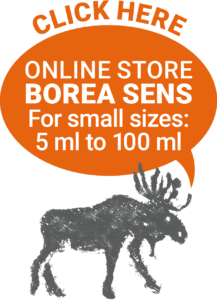BALSAM FIR BARK ESSENTIAL OIL

Latin Name: Abies balsamea
French Name: Sapin Baumier
English Name: Balsam Fir
Botanical Family Name: Pinaceae
Origin: Quebec, Canada
Harvest time: April, May, September, October
Distilled Parts: Bark
Organoleptic Characteristics: Its appearance is crystal clear with a slightly sweet resinous aroma but woodier than the Twigs and needle essential oil.
Components: α and β pinene, limonene, camphene, bornyl acetate.
ORIGIN
The Balsam Fir originates from the northern forests of central and eastern North America. This pyramidal-shaped conifer with its evergreen needles grows in various soils and climates. Like the Black Spruce, it is very resistant to the intense cold of the northern regions. It can reach up to 25 meters in height and live up to 150 years. It is distinguished from other conifers by its flat dark green needles, which are not prickly, but are fragrant, and which form two white rays when view from below. The bark vesicles contain a sticky, viscous resin called fir gum or Canadian white balsam or yet again Canadian turpentine.
HISTORY
There are many uses for conifers coming from the First Nations which are listed in literature. The First Nations, the Sisters of Providence and even the famous Hildegard von Bingen, used the Balsam Fir to treat cuts, ulcers, rheumatism, kidney pain, chronic respiratory ailments or like a tonic. This Canadian Fir is anti-scurvy. The bark was also widely used by the First Nations in a decoction or as an infusion for internal problems such as tuberculosis or diarrhea. The Ojibwa used the fir resin added to tallow or fat to make a pitch to seal their canoes. The Europeans used fir gum in optics to attach lenses because of its high quality of transparency.
Balsam Fir is the iconic Christmas tree for many Westerners. At the beginning of the Canadian winter, its slightly sweet resinous fragrance with its hint of grapefruit overflows in homes bringing warmth and happiness during the festivities of the holiday season.
BENEFITS
Balsam Fir essential oil, like Black Spruce or Scots Pine, increases energy metabolism and stimulates the organism. It is particularly useful in stopping the evolution of a cold, to tone the adrenals (hot flashes), and to relieve rheumatism and joint pain. In diffusion, it is a good antiseptic for the air with a comforting balsamic scent. It helps to relieve stress and depression.
Physical
- Circulatory system: Lymphotonic.
- Endocrine system: Cortisone-mimetic, balancing, adrenal tonic.
- Immune system: Antibacterial, winter antiseptic, antiviral, antiparasitic, vermifuge, antifungal, fast and marked immunostimulant, Koch bacillus.
- Respiratory system: Pulmonary decongestant by exocrinostimulante and lymphotonic action, bronchial antispasmodic.
- Nervous system: Analgesic, stimulating brain irrigation, relaxing: promotes sleep, antispasmodic, calms the abdominal brain and central nervous system.
- Osteo-articular system: Anti-inflammatory, analgesic, painkiller, decongestant, anti-arthritic.
Psychic
- Psycho toning
- Increases concentration capacity
- Promotes logical reasoning
- Stimulates the mind
- Increases psychic resistance
Uses: Rhinitis, bronchitis, dyspnea, sinusitis, aerophagia, anti-parasitic (ascaridioses), rheumatism, osteoarthritis, cellulite, cramps, fatigue, asthenia, air purifier.
Contra-indications: None, at physiological doses. Essential conifer oils can irritate the skin if they are oxidized.
Recommendation: Essential oils are wonderful for the well-being of humans, animals, insects and plants. There are many books that discuss aromatherapy and you should refer to them for proper and safe use. We also recommend that you consult a professional in aromatherapy who will be able to target the biochemical groups and aromatic molecules of essential oils and thus increase the effectiveness of your care.
Essential oils should be stored in a cool, dry place, protected from light and air.
The information provided on this website is NOT a recommendation of a cure or the treatment of a medical condition or disease.
VIDEOS
References
- Festy Danièle, Ma bible des huiles essentielles, Guide complet d’aromathérapie, Montréal, Éditions Caractère, 2009.
- Site officiel : Ressources naturelles Canada.
- Franchomme, P., Jollois, R,. Pénoël, D., L’aromathérapie exactement, Encyclopédie de l’utilisation thérapeutique des huiles essentielles, fondements, démonstration, illustration et applications d’une science médicale naturelle, Bayeux, Éditions Roger Jollois, 2001. Hydrosols : The Next Aromatherapy, 2001.
- http://www.wikiphyto.org
- Frère Marie-Victorin, Rouleau Ernest, Brouillet Luc et collaborateurs, Flore laurentienne 3e édition, Gaëtan Morin Éditeur ltée, 2002.
- Moerman Daniel E., Native American Ethnobotany, Timber Press, Portland, Oregon, 1998.
- Mathieu Jacques, L’annedda, l’arbre de vie, Québec, Les Éditions du Septentrion, Les cahiers du Septentrion, 2009.

